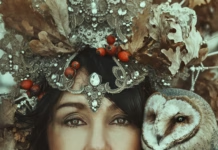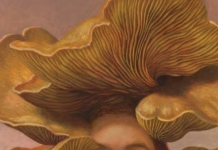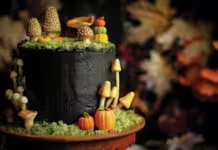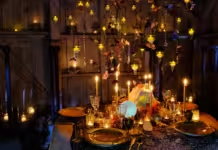The waies, through which my weary steps I guyde, In this delightfull land of Faery,
Are so exceeding spacious and wyde,
And sprinckled with such sweet variety,
Of all that pleasant is to eare or eye,
That I nigh rauisht with rare thoughts delight,
My tedious trauell doe forget thereby;
And when I gin to feele decay of might,
It strength to me supplies, & chears my dulled spright. —Book VI, The Faerie Queene
As a quixotic youngster, The Faerie Queene always caught my eye in musty used book stores. There always seemed to be a copy on the shelves: a 19th century leatherbound with flaking cover and the smoothest paper; a 1930s edition bound in green cloth with gold embossing; a hefty Penguin paperback peppered with some undergraduate’s scribbles. Of course, a number of these volumes ended up on my own shelves over the years, and when I finally traversed this storied landscape (as an undergraduate, scribbling in a paperback Penguin), I was surprised to find myself so besotted with a world that was nowhere near as richly built as others I had known and loved. Spenser’s “Faery lond” is neither lush nor whimsical: This is no Narnia, no Middle Earth. In fact, there are very few descriptions of the landscape itself, and they change drastically from section to section. But as I fell in love with the lady knight Britomart and the temperate Sir Guyon, I fell in love with Faery too. What was it about this mysterious and mutable place that captured my imagination?
The Faerie Queene is an unfinished epic poem massive in its original scope. Edmund Spenser (ca. 1552–1599) intended to write twelve sections that tell the stories of twelve knights on their quests toward specific virtues, but he died after completing just six. His heroes (and occasional shining heroine) travel through Faery, questing not only for dragons and true love
but also for the virtues of Holiness, Temperance, Chastity, Friendship, Justice, and Courtesy. In reading The Faerie Queene, I found a kindred spirit in Spenser. I love characters who strive toward some idea of virtue or goodness, no matter how embarrassingly out of step with postmodern sensibilities that may be. I am inspired by characters like Spenser’s knights, wending their way messily toward a principled future, who encourage me to strive for growth and goodness in my own life. Whether I’m struggling to let go of a grudge or to be a better listener to my loved ones, and especially when I fall short in such goals, the quests of these knights feel imperative and their little failures poignantly human. Spiritual and moral growth were so important to Spenser that he deliberately devoted an entire world to their attainment. This is part of what made Faery so appealing to me; within its landscape, the mundane task of being a better person takes on an epic resonance and becomes achievable.
I wanted to parse how the ambiguous landscape of Faery related to and differed from my own world, so I looked first to the physicality of the space. I wondered if there was something about the way Spenser’s landscape or its inhabitants looked or felt that marked it as “other,” but there were no hobbits, no Hogwarts here to identify it by. Faery looks much like the Britain of Arthurian legend, with its only otherworldly markers being the odd dragon or sorcerer. Spenser intentionally occupied an anachronistic space with this poem, even using an affected form of medieval English to enhance the appearance of high romance, so it’s not surprising that his worldbuilding also uses that idiom. Just as Arthurian Britain overlaps with our own world in some mythic, pseudo-historical way, it would appear that Spenser’s Faery should similarly map onto our own physical world. However, Spenser assures us that this is not the case, asserting that “none, that breatheth liuing aire, does know, / Where is that happy land of Faery.” Not to mention the shimmering, transcendent quality that marks it as something other than our own.
So if Faery isn’t easily defined by the feel of its landscape, what is it about this place that feels so magical? And if Spenser isn’t interested in worldbuilding in the traditional sense, then why not set these quests in his own world? The answers lie in the particular journeys of his protagonists. Because Spenser is interested in his characters’ moral development, Faery provides an entirely different setting for every journey. For each of his questers, the landscape offers the perfect combination of challenges, resources, and examples to aid them in realizing their goals. Sir Guyon, in his quest for Temperance, must be provided with a hedonistic “Bower of Bliss” to resist and, ultimately, destroy. When the Redcrosse Knight must learn Holiness, Faery offers up the perfect example in Una and her lion. This nature of “offering,” is where the mystery and even magic of Spenser’s Faery exists: Unlike other created worlds, it looks strikingly like our own, except for the way it seems to provide the perfect support to its heroes’ quests, co-creating their virtue with them.
This is the crux of what makes Faery so alluring. Faery actively participates in the spiritual growth of those who wander its terrain, and I wanted to enter that space, to see my own faltering journey strengthened and supported by a benign and even sentient world. I wished my environment could offer up the precise formula of challenges, resources, and examples to guarantee my own success. No wonder we never see any of Spenser’s heroes return to the real world after their quests are over. Who wouldn’t wish to remain in a world that worked its creative forces upon your own being? This troubled me, though. I couldn’t imagine that Spenser would just abandon his heroes in a well-wrought, virtuous limbo, with no hope of bringing their growth back into their own lives. We all know that an important part of the hero’s journey is the return to the ordinary world, that the journey must always be “there and back again.”
As I wend through my own mutable landscape, questing after virtue and often falling short of my own expectations, I question whether Faery really is, as Spenser suggested, somewhere out there. The idea of this magical world, with its intrinsic nature of offering, of co-creating spiritual growth with the people that wander within it, is appealing but not unfamiliar. In this very ordinary world, when I find myself wandering the local cemetery with a case of severe February hopelessness, I am sure to find snowdrops. When I fear cataclysmic change, I watch the old maple in my garden thrash about in the wind without shedding a branch. When I feel at a loss in a situation, it never fails that the right advice comes my way, whether in the form of a serendipitous library book or a letter from a friend. When anxiety about the future of my home planet threatens to overwhelm me, I pick up trash in my neighborhood woods and marvel at the way that even plastic bags have degraded in a handful of years, burgeoning with fungus and seedlings and insects and even the odd salamander. If Faery land’s true nature is offering and co-creation, then I’ve been here all along.






























